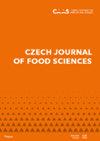乳和乳制品蛋白质提取方法及营养价值的比较
IF 1
4区 农林科学
Q4 FOOD SCIENCE & TECHNOLOGY
引用次数: 0
摘要
蛋白质是仅次于核酸的第二重要大分子。本文旨在对牛奶和乳制品的提取方法和营养价值进行比较分析。蛋白质形成身体质量并执行几个关键任务,包括充当催化剂和在体内进行不同的代谢反应。此外,蛋白质充当转运蛋白,传递神经冲动,提供机械支持或免疫保护,并控制生长。蛋白质有几种来源,但牛奶由于其生物活性而占有重要地位。牛奶及其产品对健康的巨大益处来自蛋白质。酸奶和奶酪在奶制品中占有重要地位。牛奶及其产品的蛋白质可以通过匀浆、离心和脱蛋白调节pH值来提取。有几种技术可以鉴定和量化牛奶和产品蛋白质。凯氏定氮法和分光光度法是定量牛奶及其产品中蛋白质最广泛使用的方法。此外,这些技术包括电泳和色谱方法,包括天然凝胶电泳、十二烷基硫酸钠-聚丙烯酰胺凝胶电泳(SDS-PAGE)、尿素PAGE、毛细管电泳和等电聚焦。一些是色谱方法,如反相高效液相色谱法(RP-HPLC)、尺寸排阻色谱法和离子交换色谱法。每种技术都有其优点和缺点。该过程的选择取决于蛋白质的类型。从牛奶及其产品中提取的蛋白质具有许多健康或治疗作用,表现出抗菌、抗增殖、抗氧化、抗高血压、抗癌、抗病毒和免疫调节作用。酸奶在乳制品中具有首要的重要性,因为它具有治疗作用和更多的蛋白质。本文章由计算机程序翻译,如有差异,请以英文原文为准。
Comparison of extraction methods and nutritional benefits of proteins of milk and dairy products: A review
Proteins are the second most essential macromolecules after nucleic acids. This article aimed at the comparative analysis of extraction methods and nutritional benefits of milk and dairy products. Proteins form the body mass and perform several crucial tasks that include acting as a catalyst and carrying out different metabolic reactions in the body. Furthermore, protein acts as a transporter, transmits nerve impulses, provides mechanical support or immune protection, and controls growth. Several sources of proteins are present, but milk holds an important place due to its biological activities. The considerable health benefits of milk and its products are due to proteins. Yoghurt and cheese have significant importance among milk products. Proteins of milk and its products can be extracted by pH adjustment through homogenisation, centrifugation, and deproteinisation. There are several techniques for identifying and quantifying milk and product proteins. The Kjeldahl and spectrophotometric methods are the most widely used methods for quantifying proteins in milk and its products. Furthermore, these techniques include electrophoresis and chromatographic methods, including native gel electrophoresis, sodium dodecyl sulfate-polyacrylamide gel electrophoresis (SDS-PAGE), urea-PAGE, capillary electrophoresis, and isoelectric focusing. A few are chromatographic methods like reverse-phase high-performance liquid chromatography (RP-HPLC), size exclusion chromatography, and ion-exchange chromatography. Each technique has its advantages as well as disadvantages. The selection of the process depends upon the type of protein. The extracted proteins from milk and its products have many health or therapeutic effects that exhibit antimicrobial, antiproliferative, antioxidant, antihypertensive, anticancer, antiviral, and immunomodulatory effects. Yoghurt has prime importance among milk products because of its therapeutic effects and more protein.
求助全文
通过发布文献求助,成功后即可免费获取论文全文。
去求助
来源期刊

Czech Journal of Food Sciences
Food Science & Technology, Chemistry-食品科技
CiteScore
2.60
自引率
0.00%
发文量
48
审稿时长
7 months
期刊介绍:
Original research, critical review articles, and short communications dealing with food technology and processing (including food biochemistry, mikrobiology, analyse, engineering, nutrition and economy). Papers are published in English.
 求助内容:
求助内容: 应助结果提醒方式:
应助结果提醒方式:


